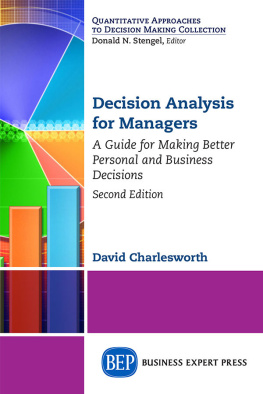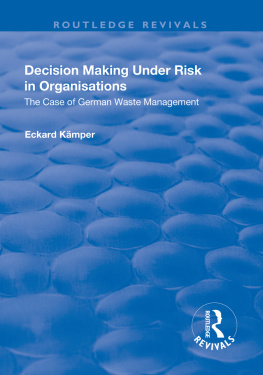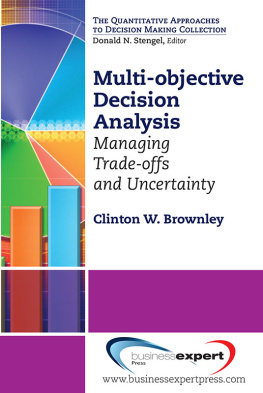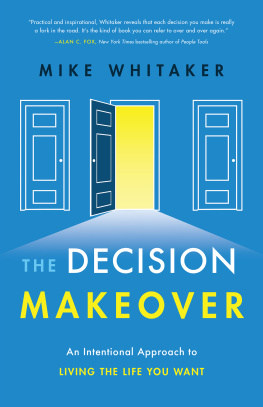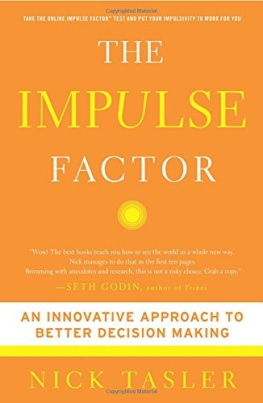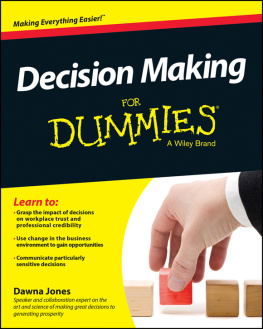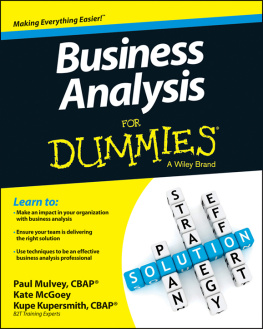Decision Analysis
for Managers
Decision Analysis
for Managers
A Guide for Making Better
Personal and Business Decisions
Second Edition
David Charlesworth

Decision Analysis for Managers: A Guide for Making Better Personal and Business Decisions, Second Edition
Copyright Business Expert Press, LLC, 2017.
All rights reserved. No part of this publication may be reproduced, stored in a retrieval system, or transmitted in any form or by any meanselectronic, mechanical, photocopy, recording, or any other except for brief quotations, not to exceed 400 words, without the prior permission of the publisher.
Excel, PowerPoint, Visio, and Word are Microsoft Corporation trademarks. Analytica is a Lumina Corporation trademark. Crystal Ball is an Adobe Corporation trademark. TreeAge Data is a TreeAge Software Inc. trademark. @Risk is a Palisades Corporation trademark.
First published in 2013 by
Business Expert Press, LLC
222 East 46th Street, New York, NY 10017
www.businessexpertpress.com
ISBN-13: 978-1-63157-604-1 (paperback)
ISBN-13: 978-1-63157-605-8 (e-book)
Business Expert Press Quantitative Approaches to Decision Making Collection
Collection ISSN: 2163-9515 (print)
Collection ISSN: 2163-9582 (electronic)
Cover and interior design by Exeter Premedia Services Private Ltd., Chennai, India
Second edition: 2017
10 9 8 7 6 5 4 3 2 1
Printed in the United States of America.
Abstract
Everybody has to make decisionsthey are unavoidable. Yet we receive little or no education or training on how to make decisions. Decision making can be difficult, both in business (hiring, product development, capacity, bidding, balancing R&D versus compliance spending, etc.) and your personal life (dating and marriage, which automobile or house to buy, whether to change jobs or not, where to vacation, retirement, how to deal with health problems, etc.).
Decision Analysis (DA) is a time-tested set of tools (mental frameworks) that will help you and people you work with:
Clarify and reach alignment on goals and objectives,
Understand trade-offs associated with reaching your goals,
Develop and examine alternatives,
Systematically analyze the effects of risk and uncertainty, and
Maximize the chances of achieving your goals and objectives.
Success (getting what you want) depends on luck and good decision making. You cant control your luck, but you can maximize your odds by making the best possible decisions.
Broadly speaking, this book organizes and presents otherwise formal decision-making tools in an intuitively understandable fashion. The presentation is informal, but the concepts and tools are research-based and formally accepted. Whether you are a business owner, a manager or team leader, or a senior professional, these tools will help you make better decisions in both your personal and your business life.
In the second edition of Decision Analysis for Managers, chapters focusing on risk analysis and decision quality have been added.
Keywords
business decision making, decision analysis, decision and risk analysis (D&RA), decision framing, decision making under uncertainty, decision quality, making decisions, multiattribute decision analysis, personal decision making, portfolio analysis, project risk, risk, strategic decision making, trade-offs, uncertainty
Contents
Everybody has to make decisionsthey are unavoidable. Yet we receive little or no education or training on how to make decisions. Business decisions can be difficult: which people to hire, which product lines or facilities to expand and which to sell or shut down, which bid or proposal to accept, which process to implement, how much R&D to invest in, which projects should receive the highest priority and which should be deferred, and so on. Even if you make the correct decision, you still have to get buy-in and commitment from your team, upper management, other managers, and key stakeholders to successfully implement the decision.
Personal decisions can be even more difficult: which college to attend, who to date, who to marry, which automobile to buy, which house to buy, whether to change jobs or not, where to go on vacation, when and where to retire, making decisions concerning a serious illness or health problem, and so on.
Decision analysis (DA) is a time-tested set of tools (mental frameworks) that will help you, your teams, your peers, and your family:
clarify and reach alignment on goals and objectives,
understand trade-offs associated with reaching those goals,
develop and examine alternatives,
systematically analyze the effect of uncertainty, and
maximize the chances of achieving your goals and objectives.
Success (getting what you want) depends on luck and good decision making. You cant control your luck, but you can maximize your odds by making the best possible decisions. This book introduces you to tools that can help you make better personal decisions and that will help teams and work groups align quickly and make better recommendations and decisions. It gives you frameworks for gaining insight when the decisions and/or the people involved in those decisions are difficult. Whether you are a business owner, a manager or team leader, or a senior professional, these tools will help both your personal and your business life.
It is difficult to list all the people who help a person formulate a set of experiences and frameworks that constitute a career. Ive been fortunate to have had the opportunities to work on challenging and interesting problems with some rather amazing people. Here are the high pointserrors of omission are sincerely regretted! Well start with decision analysis (DA): Tom Sciance (now an adjunct professor at the University of Texas) was the visionary leader at Conoco who started both David Skinner (author of Introduction to Decision Analysis) and me on the DA adventure. SDG was our early DA mentor and helped us through those first Conoco projects. Hollis Call of ADA was also a source of advice and encouragement. Gary Bush, Pat Leach, Bill Haskett, Nick Martino, Paul Wicker, OJ Sanchez, Stefan Choquette, James Mitchell, Bob DeWolff, Mike Stallsworth, and the rest of the early DSI (Decision Strategies, Inc.) gang influenced my thinking about DA considerably and provided helpful advice, ideas, and collaboration. Professors Ronald Howard (Stanford), Bob Winkler (Duke), and Bob Clemens (Duke) have been inspiring and encouraging.
In my association with Chevron for over 13 years (consultant and employee), Im grateful that I was able to work in a company that is serious about using state-of-the-art decision science. Frank Koch, Larry Neal, Elton Allen, Dale Nichols, Jeff Circle, and Craig McKnight have been very generous with their time, ideas, encouragement, and collaboration.
My underlying management philosophy was influenced most by John OBryan, Dave French, John Lindsay, and Jarl Swanson of the bygone Louviers (DuPont) training group (and our gurus, Ed Klinge and Ted Keegan). Im grateful to the teams that I managed at Parkersburg, Savannah River (now SRNL), Ponca City, and Gainesville for putting up with and responding to my constant pushing for synergy and a skunk works culture. People Ive known who led by example and served as role models and inspiration include Herb Eleuterio, Bob Cook, and Tom Sciance (DuPont), Todd Wright, Harry Harmon, and Ed Albenesius (SRNL), John Bailey (PCR), and Sam Trobee, Bill Hauhe, and Doug Quillen (Chevron). Manny Gonzalez, (retired Chevron Alliance Manager) is one of the most successful entrepreneurs Ive ever met and was an absolute joy to work with (his bosses, Matt Palmer, Melody Meyer, and Paul Siegele are to be commended for letting Manny run).
Next page
